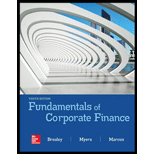
a)
To discuss:
a)
Explanation of Solution
Generally free cash flow involves three elements they are as follows,
- Interest paid to the debt holders of the company.
- Cash available to the shareholders of the company.
- Finally, subtract cash necessary to pay for new investments.
Hence, net working capital is -$258.
Here, capital expenditure is $3,049. Therefore,
Hence, free cash flow is $4,077.
b)
To determine: Tax to be paid by Company Q if it is entirely financed by equity.
b)
Explanation of Solution
From the income statement it is observed that, interest expense amounting to $517 has paid to debt fund holders. If company has entirely financed by equity there is no need of payment of interest. So that amount is also treated as income. On that income, Company has to pay 21% corporate tax to the government.
Therefore the amount of $108.57 has been additionally paid by company to government.
c)
To determine: Company’s free cash flow if the type of funding is through equity only.
c)
Explanation of Solution
Free cash flow is calculated by deducting capital expenditures from the cash flow from operations.
The amount of net income is given in the question as $5,465.
Here, capital expenditure is $3,049. Therefore,
$3,896 is the free cash flow of company if it was funded totally by equity.
Want to see more full solutions like this?
Chapter 3 Solutions
FUNDAMENTALS OF CORPORATE FINANCE
- Please help with questionsarrow_forwardCreate financial forecasting years 2022, 2023, and 2024 using this balance sheet.arrow_forwardBeta Company Ltd issued 10% perpetual debt of Rs. 1,00,000. The company's tax rate is 50%. Determine the cost of capital (before tax as well as after tax) assuming the debt is issued at 10 percent premium. helparrow_forward
 Essentials Of InvestmentsFinanceISBN:9781260013924Author:Bodie, Zvi, Kane, Alex, MARCUS, Alan J.Publisher:Mcgraw-hill Education,
Essentials Of InvestmentsFinanceISBN:9781260013924Author:Bodie, Zvi, Kane, Alex, MARCUS, Alan J.Publisher:Mcgraw-hill Education,

 Foundations Of FinanceFinanceISBN:9780134897264Author:KEOWN, Arthur J., Martin, John D., PETTY, J. WilliamPublisher:Pearson,
Foundations Of FinanceFinanceISBN:9780134897264Author:KEOWN, Arthur J., Martin, John D., PETTY, J. WilliamPublisher:Pearson, Fundamentals of Financial Management (MindTap Cou...FinanceISBN:9781337395250Author:Eugene F. Brigham, Joel F. HoustonPublisher:Cengage Learning
Fundamentals of Financial Management (MindTap Cou...FinanceISBN:9781337395250Author:Eugene F. Brigham, Joel F. HoustonPublisher:Cengage Learning Corporate Finance (The Mcgraw-hill/Irwin Series i...FinanceISBN:9780077861759Author:Stephen A. Ross Franco Modigliani Professor of Financial Economics Professor, Randolph W Westerfield Robert R. Dockson Deans Chair in Bus. Admin., Jeffrey Jaffe, Bradford D Jordan ProfessorPublisher:McGraw-Hill Education
Corporate Finance (The Mcgraw-hill/Irwin Series i...FinanceISBN:9780077861759Author:Stephen A. Ross Franco Modigliani Professor of Financial Economics Professor, Randolph W Westerfield Robert R. Dockson Deans Chair in Bus. Admin., Jeffrey Jaffe, Bradford D Jordan ProfessorPublisher:McGraw-Hill Education





